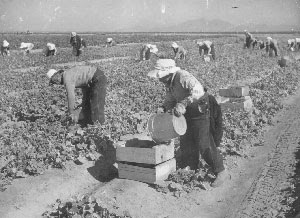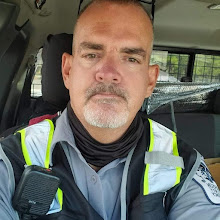The Gila River War Relocation Center
The camp was located on the Gila River Indian Reservation about 50 miles
southeast of Phoenix, near the town of Rivers. The 16,500-acre site actually
consisted of two separate camps, with the larger of the two, Butte Camp, located
3-1/2 miles west of Canal Camp. The Sacaton Mountains rise three miles to the
south and the Superstition Mountains are visible in the distance. The average
summer temperature is 104 degrees and has been known to reach 125 degrees.
Despite the Gila River Indian Tribe’s objections, the site was approved, and
construction began on May 1, 1942. The camp officially opened on July 20, 1942,
and evacuees streamed in from the Sacramento Delta area, Fresno County and the
Los Angeles area. (Another 2,000 came from the Jerome Relocation Center
in Arkansas after its closing in June 1944). By December 1942, Gila River had a
peak population of 13,348 and was Arizona’s fourth largest city. Canal Camp
closed on September 28, 1945, and Butte Camp closed on November 10, 1945.
Gila River Internment Center - Rivers, Arizona
Memorial marker at Butte Camp
Butte Camp had 821 buildings, including 22 administration offices,
warehouses, and staff housing. There was a post office, garages, mimeograph
buildings, warehouses, police office, court, water filtration plant,
refrigerated warehouse, laundry, gas station and various other staff buildings,
most of which were built by the evacuees. Butte Camp had 627 residential
barracks of which 46 were used for the schools, 6 for churches, and 29 for other
services, including a shoe repair shop, sewing shop, laundry and dry cleaning,
barber shop, beauty shop, canteen, store, and a kitchen.
Memorial marker at Butte Camp listing the names
of Japanese Americans from the
Gila River Relocation Center killed in World War II.
These barracks were made of wood and fireproof shingles that blocked out the desert heat. Each barrack was made to house four single families in separate apartments. Unfortunately, the camp exceeded its capacity: it was designed for 10,000 residents, but held over 13,000. Because of this some families resorted to living in the mess hall or recreation buildings and used blankets as makeshift walls. Water shortages also plagued the camp, and poisonous rattlesnakes and scorpions kept Butte Hospital extremely busy.
Cultural, civic and religious activities flourished with in the camp.
Recreation buildings and barracks were used for churches, meeting rooms,
libraries, and other community services. There was an active Japanese American
Citizens League, as well as Boy Scouts, American Legion and other groups.
Both
Buddhist and Christian congregations held church services.
Internees could also
maintain relationships with people on the outside and were able to obtain passes
for visitors to enter the camp.
The schools enrolled several thousand students from kindergarten through high
school. One entire block housed an elementary school and another was used for
the high school. The internees built an auditorium and additional classroom
buildings for science, home economics, and vocational studies.
Students and
teachers alike had to make do with a lack of materials, but they were
resourceful in creating ways around the shortages. The typing class had only two
typewriters, so students practiced on cardboard diagrams of an actual keyboard.
Desks and chairs were made by students in the vocational school, and painted
walls served as blackboards. Most of the teachers were Japanese American, many
with college degrees and some with teaching experience.
The State of Arizona
accredited the schools in both camps, and 97 seniors graduated from Canal High
School in 1944. In addition, a variety of adult classes were held during the day
and in the evening under the direction of an adult education department.
Memorial marker at Canal Camp
Canal Camp had 404 buildings, with 44 for administrative purposes, 232 barracks
for living quarters, 16 mess halls, 17 ironing rooms, 17 laundry rooms, 34
latrine and shower buildings, 24 school buildings and 20 community service
buildings. Residential sections were divided into blocks of 14 barracks. Each
barrack was 20 by 100 square feet and divided into four single-family
apartments.
Rebuilding their lives on the outside was a difficult prospect because many
who had been interned were not sure where to go. Some families were able to
relocate to the Midwest or the East Coast; the rest remained in Arizona or
returned to the West Coast. By the fall of 1945, the last to leave were 155
Hawaiian Japanese. In December most of the buildings were moved to other
institutions in Arizona, although many of the internees chose to stay in the
camps until the war ended and restrictions were lifted in January 1945.
Butte Camp, Gila River Relocation Center
Canal Camp, Gila River Relocation Center
Group of Japanese American children at the Gila River Relocation Center, August
1943.
Harvesting cucumbers at the Gila River Relocation Center
Growing experimetnal plants at the Gila River Relocation Center
Harvesting daikon at the Gila River Relocation Center
Sites in the western U.S. associated with the relocation
of Japanese Americans
during World War II.
What the Camps look like today.
Americans of Japanese Ancestry Who Died in World War II
| Unit | First Name | Last Name |
Rank
|
Hometown
|
Date Died |
Battles
|
Grave
|
Camp
|
| 1.100-C | Masashi | ARAKI |
Pfc
|
Selma, CA |
02-Jun-44
|
Anzio to Rome | US | Gila River |
| 6.MIS | Russell T. | FUJINO |
T/Sgt
|
San Francisco, CA |
4-Aug-45
|
Golden Gate | Gila River | |
| 1.100-A | Tatsumi | FURUKAWA |
Pvt
|
Concord, CA |
20-Oct-44
|
Battle of Bruyeres | Golden Gate | Gila River |
| 3.442-L | John T. | HASHIMOTO |
Sgt
|
Fresno, CA |
14-Nov-44
|
Vosges Mtn -St. Die | Seattle, WA | Gila River |
| 2.442-E | Yeiichi | HIYAMA |
Pvt
|
Fowler, CA |
23-Apr-45
|
Po Valley Campaign | Gila River | |
| 2.442-G | Minoru | ISHIDA |
Pfc
|
San Marino, CA |
23-Apr-45
|
Po Valley Campaign | Evergreen, LA | Gila River |
| 1.100-A | James J. | KANADA |
Pvt
|
Concord, CA |
05-Apr-45
|
Po Valley Campaign | Golden Gate | Gila River |
| 2.442-F | Shaw | KOJAKU |
Pfc
|
Gardena, CA |
17-Jul-44
|
Rome-Arno | Evergreen, LA | Gila River |
| 2.442-E | Nobuo | KOMOTO |
Pfc
|
Selma, CA |
17-Oct-44
|
Battle of Bruyeres | Gila River | |
| 2.442-E | Henry M. | KONDO |
Pfc
|
Pasadena, CA |
19-Oct-44
|
Battle of Bruyeres | Gila River | |
| 6.MIS | Satoshi B. | KUROKAWA |
T/4
|
Guadalupe, CA |
13-Aug-45
|
Plane Crash, Okinawa | Gila River | |
| 2.442-F | Kazuo | MASUDA |
S/Sgt
|
Santa Ana, CA |
27-Aug-44
|
Rome-Arno | Gila River | |
| 2.442-E | George H. | MASUMOTO |
Pfc
|
Selma, CA |
16-Oct-44
|
Battle of Bruyeres | Gila River | |
| 1.100-C | Takanori A. | NISHI |
Pfc
|
San Francisco, CA |
15-Jul-44
|
Rome-Arno | Golden Gate | Gila River |
| 4.442-Can | George | OTA |
Pvt
|
Parlier, CA |
15-Aug-44
|
Rome-Arno | Gila River | |
| 2.442-G | Kazuo | OTANI |
S/Sgt
|
Visalia, CA |
15-Jul-44
|
Rome-Arno | Gila River | |
| 2.442-G | Todd T. | SAKOHIRA |
Pfc
|
Fowler, CA |
04-Jul-44
|
Rome-Arno | Gila River | |
| 6.MIS | George M. | SHIKATA |
T/3
|
Los Angeles, CA |
21-Jul-46
|
Died Non-Battle | Gila River | |
| 1.100-C | Katsumi L. | TAKASUGI |
T/Sgt
|
Ventura, CA |
05-Apr-45
|
Po Valley Campaign | US | Gila River |
| 4. 442-? | Masuo | WAKITA |
Pfc
|
Santa Ana, CA |
23-Aug-45
|
Died Non-Battle | Gila River | |
| 3.442-L | Mitsuru T. | YETO |
Pvt
|
Oxnard, CA |
19-Apr-45
|
Po Valley Campaign | Evergreen, LA | Gila River |
| 7.Army | Makoto | YOSHIHARA |
Pvt
|
Guadalupe, CA |
22-Dec-44
|
Died Non-Battle | Gila River |
As the land for the camp sites is owned by the Gila River Indian Tribe and is considered sacred by them, public access to the sites is currently restricted. Although all the main structures are long gone, some artifacts such as the road grid, concrete slab foundations, manholes, cisterns, several rock alignments and dozens of small ponds remain today.























































































